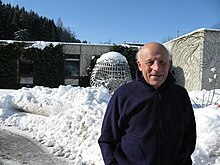Pierre Émile Cartier (10 June 1932 – 17 August 2024) was a French mathematician. An associate of the Bourbaki group and at one time a colleague of Alexander Grothendieck, his interests have ranged over algebraic geometry, representation theory, mathematical physics, and category theory.
Pierre Cartier | |
|---|---|
 Cartier in 2009 | |
| Born | Pierre Émile Cartier 10 June 1932 |
| Died | 17 August 2024 (aged 92) Marcoussis, France |
| Education | Lycée Saint-Louis |
| Alma mater | École normale supérieure University of Paris |
| Known for | Cartier divisor Cartier duality Cartier isomorphism Cartier operator Cartier's theorem Cartier–Foata matrices Traces |
| Awards | Prix Peccot (1960)[1] ICM Speaker (1970) Prize Ampère (1978) |
| Scientific career | |
| Fields | Mathematics |
| Institutions | University of Strasbourg Institut des Hautes Études Scientifiques |
| Doctoral advisor | Henri Cartan André Weil |
| Doctoral students | Guy Henniart |
Life and career
editCartier was born on 10 June 1932. He studied at the École Normale Supérieure in Paris under Henri Cartan and André Weil.[2] After his 1958 thesis on algebraic geometry, he worked in a number of fields. He is known for the introduction of the Cartier operator in algebraic geometry in characteristic p, and for work on duality of abelian varieties and on formal groups. He is the eponym of Cartier divisors and Cartier duality.
From 1961 to 1971, he was a professor at the University of Strasbourg. In 1970 he was an Invited Speaker at the International Congress of Mathematicians in Nice.[3] He was awarded the 1978 Prize Ampère of the French Academy of Sciences.[4] In 2012 he became a fellow of the American Mathematical Society.[5]
Cartier died in Marcoussis on 17 August 2024, at the age of 92.[6]
Publications
edit- Cartier, Pierre; Foata, Dominique (14 November 2006). Problèmes combinatoires de commutation et réarrangements. Springer. ISBN 9783540360940. (1st edition 1969)[7]
- Waldschmidt, Michel; Moussa, Pierre; Luck, Jean-Marc; Itzykson, Claude, eds. (9 March 2013). "An introduction to zeta functions by Pierre Cartier". From Number Theory to Physics. Springer. pp. 1–63. ISBN 9783662028384. (1st edition 1992)
- "A primer of Hopf algebras" (PDF). Report Number IHES-M-2006-40: 1–74. September 2006.
- Freedom in Mathematics, Springer India, 2016 (with Cédric Villani, Jean Dhombres, Gerhard Heinzmann), ISBN 978-81-322-2786-1.[8]
- Translation from the French language edition: Mathématiques en liberté, La Ville Brûle, Montreuil 2012, ISBN 978-23-601-2026-0.
- Pierre Cartier: Alexander Grothendieck. A country known only by name. Notices AMS, vol. 62, 2015, no. 4, pp. 373–382, PDF.
As editor
edit- Cartier, Pierre; Illusie, Luc; Katz, Nicholas M.; Laumon, Gérard; Manin, Yuri I.; Ribet, Kenneth A., eds. (23 October 2007). The Grothendieck Festschrift, Volume III: A Collection of Articles Written in Honor of the 60th Birthday of Alexander Grothendieck. Springer. ISBN 9780817645762. (1st edition 1990)
- Cartier, Pierre É.; Julia, Bernard; Moussa, Pierre; Vanhove, Pierre, eds. (18 July 2007). Frontiers in Number Theory, Physics, and Geometry II: On Conformal Field Theories, Discrete Groups and Renormalization. Springer. ISBN 9783540303084.
See also
editReferences
edit- ^ "Pierre Cartier". Institute for Advanced Study. 9 December 2019.
- ^ Pierre Cartier at the Mathematics Genealogy Project
- ^ Cartier, Pierre (1970). "Groupes formels, fonctions automorphes et fonctions zeta des courbes elliptiques" (PDF). In: Actes des Congrés intern. Math. Vol. tome 2. pp. 291–299. Archived from the original (PDF) on 2017-07-06. Retrieved 2017-11-14.
- ^ "40 ans du Prix Ampère" (PDF). Académie des sciences. 18 October 2016.
- ^ List of Fellows of the American Mathematical Society, retrieved 2012-11-10.
- ^ Pierre Cartier, mathématicien français, est mort Le Monde (in French)
- ^ "Commutation and Rearrangements, An electronic reedition of the monograph: Problèmes combinatoires de commutation et réarrangements by Pierre Cartier and Dominique Foata". European Mathematical Information Service (EMIS).
- ^ Glass, Darren (July 7, 2016). "Review of Freedom in Mathematics by Pierre Cartier, Jean Dhombres, Gerhard Heinzmann, and Cédric Villani". MAA Reviews, Mathematical Association of America.
External links
edit- Cartier's website at the Institut des Hautes Études Scientifiques, with a photograph, CV, and list of publications
- Issue of Moscow Mathematical Journal dedicated to Pierre Cartier
- O'Connor, John J.; Robertson, Edmund F., "Pierre Émile Jean Cartier", MacTutor History of Mathematics Archive, University of St Andrews
- Javier Fresán The Castle of Groups, Interview with Pierre Cartier, EMS Newsletter 2009, pdf
- "Pierre Cartier: Logarithmic divergences, ..." YouTube. Hausdorff Center for Mathematics. December 4, 2014.
- "Pierre Cartier. Schemes". YouTube. ERC PhiloQuantumGravity. November 29, 2015.
- "Pierre Cartier - Conférence inaugurale". YouTube. Institut des Hautes Études Scientifiques (IHÉS). December 3, 2015.
- "Pierre Cartier: Is History of Mathematics a Part of General History". YouTube. Prague Axiomatic Circle. May 10, 2018.